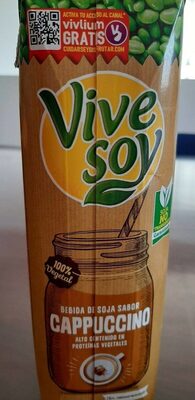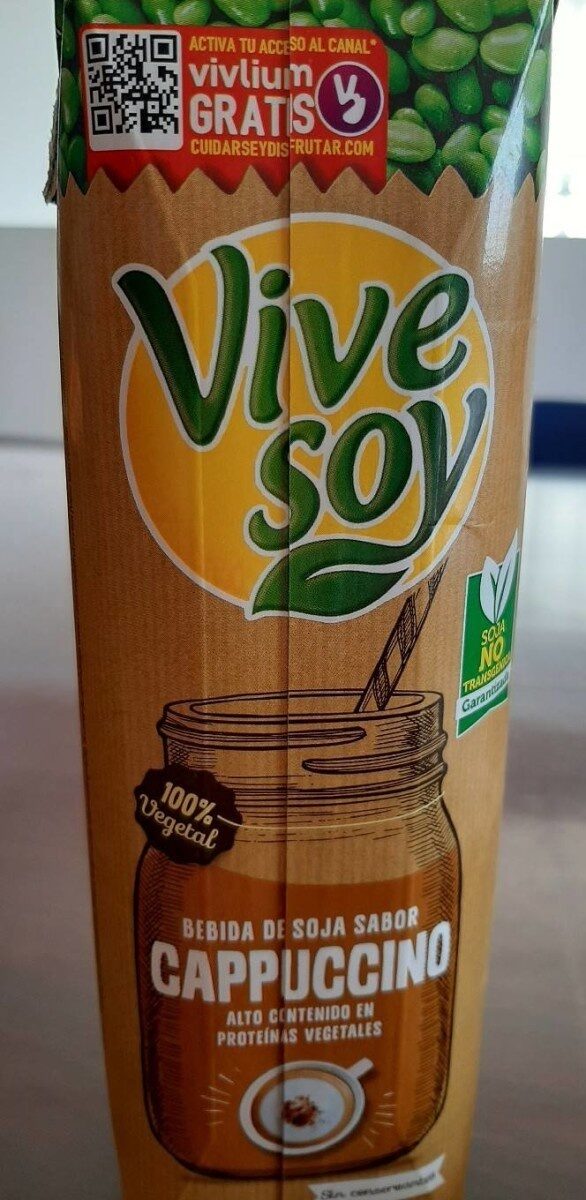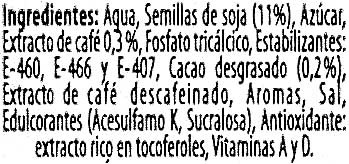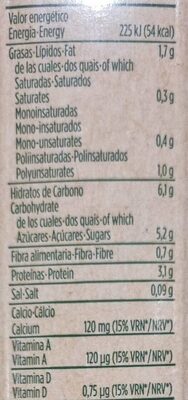Vive Soy Cappuccino - ViveSoy - 1 l
This product page is not complete. You can help to complete it by editing it and adding more data from the photos we have, or by taking more photos using the app for Android or iPhone/iPad. Thank you!
×
Barcode: 8410128670184 (EAN / EAN-13)
Common name: Bebida de soja con sabor a cappuccino con un toque de cacao con calcio y vitaminas A y D
Quantity: 1 l
Packaging: Tetra Pak, Tetra Brik
Brands: ViveSoy
Categories: Plant-based foods and beverages, Beverages, Plant-based foods, Legumes and their products, Dairy substitutes, Milk substitutes, Plant-based beverages, Plant-based milk alternatives, Artificially sweetened beverages, Legume-based drinks, Coffee drinks, Soy-based drinks, Chocolate soy-based drinks, Coffee soy-based drinks
Labels, certifications, awards:
No gluten, Vegetarian, Halal, No GMOs, FSC, No lactose

Manufacturing or processing places: Aranda de Duero, Burgos (provincia), Castilla y León, España
Traceability code: ES 21.10883/BU CE, FABRICANTE Y ENVASADOR:, CALIDAD PASCUAL S.A.U., PERTENECIENTE A:, CORPORACIÓN EMPRESARIAL PASCUAL S.L.
Link to the product page on the official site of the producer: http://www.vivesoy.com/productos-de-soja...
Countries where sold: Spain
Matching with your preferences
Environment
Carbon footprint
Packaging
Transportation
Report a problem
Data sources
Product added on by javichu
Last edit of product page on by ecoscore-impact-estimator.
Product page also edited by acuario, drsromero, kiliweb, neptuno, packbot, roboto-app, sioul, tacite-mass-editor, thaialagata, yuka.AqESDeaKPN59MPPr_oUL7iakNOHgEvhUKVRUow, yuka.ArRaA-KlBpM_O8bTgaQK-gqDDL_MKqNeHH8mog, yuka.D5RrbcaMIJcaBMTP0JwVxgemGP_pUvZQG3Urog, yuka.DbtgPf21PeEFPsbr2L8a0Ci4SvfdH_pjKUVXow, yuka.HJVZOvy7QsEiPPPTzoMm_maGOsbAB6d3E2BXog, yuka.IL9hO4SLJsBwPMr4ibwU9wXmJce7AdxwCn0Pog, yuka.LLlcEMOrIuJxJfbZ_5IKx2WBEcvcCsBlIlI9og, yuka.MZJ7F_yCA5IqGcXAzq1tgAmDOcL8Hf5UPH5Sog, yuka.MrlNFdKWHsYBN_bR7qYKwQa3DPrcD9NkGWcQog, yuka.U5J9bMCGJdUZGsvq6pg4-WS-Ge3bLMIFJFNVow, yuka.Ue9LI9vaHeUNOfP31rhp1WWqM9-5WuBFGUxSog, yuka.WGJvZEdwbGErTllVbzlndjFSU1BvOTBvd01YeUFHcU9CL0lmSVE9PQ, yuka.XJ15HcSMHcENHMfQ_qM74gedKbe_J6IHAXkLog, yuka.sY2b0xO6T85zoF3NwEKvlmN5VtGHnSn8b0TloWnVmveHDbz2OOBxwrHkGqo, yukafix.










